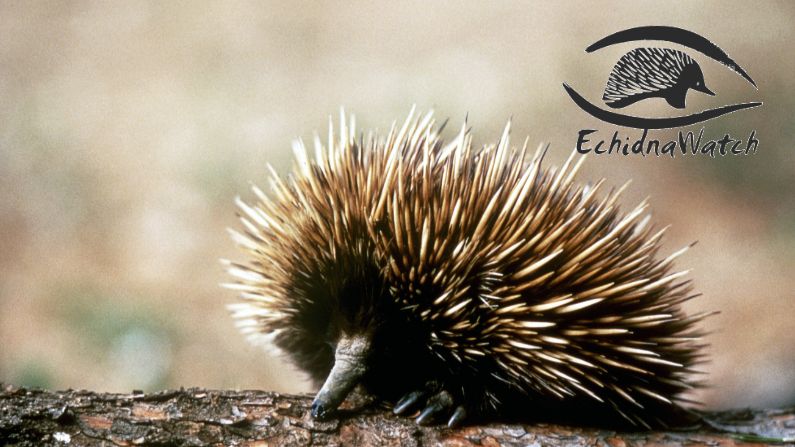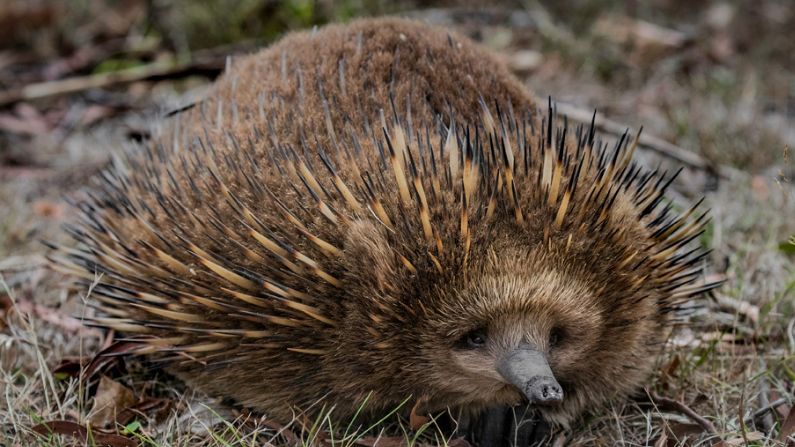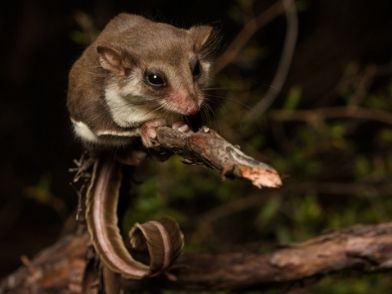Short-beaked echidna
@ Michael Schmid
The short-beaked echidna (Tachyglossus aculeatus) is Australia’s most widespread animal. Tachyglossus means ‘quick tongue’, referring to the speed with which the echidna uses its tongue to catch ants and termites. Aculeatus means ‘spiny’. Echidnas, together with the platypus, are the world’s only monotremes, or egg-laying mammals.
Quick facts
Short-beaked echidna
SCIENTIFIC NAME:
Tachyglossus aculeatus
FAMILY:
Tachyglossidae
ALSO KNOWN AS:
spiny anteater, nyingarn (Beeloo, WA), tjilkamata (Pitjantjatjara, Central Australia), minha kekoywa (Pakanh, Cape York Peninsula)
QLD CONSERVATION STATUS:
Least Concern
NATIONAL CONSERVATION STATUS:
Not listed
How we are helping echidnas
Wildlife Queensland’s dedicated EchidnaWatch program aims to collate information on the distribution of echidnas in Queensland. We can share this information with Wildnet, the wildlife data repository for the EPA, and other organisations, to help plan for better outcomes for echidnas.
 © Canva NFP
© Canva NFP
Did you know?
The short-beaked echidna was first described in writing on 9 February 1792 in Captain Bligh’s log on HMS Bounty. In the same year, naturalist George Shaw first gave the echidna a scientific name.

Threats to the short-beaked echidna
- Threats to young echidnas include: dingoes, goannas, snakes and feral cats.
- Threats to adult echidnas include: dingoes, dogs and eagles.
- Cars: echidnas are a frequent casualty on roads.
- Echidnas are also vulnerable to habitat loss from land clearing and development.
Home range
- Large overlapping home ranges of 45–50 hectares.
Distribution
Echidnas are found throughout Australia. It is the country’s most widespread native animal.
5 subspecies of short-beaked echidna are found in different regions of Australia:
- T. a. multiaculeatus: Kangaroo Island
- T. a. setosus: Tasmania and some Bass Strait islands
- T. a. acanthion: Northern Territory and Western Australia
- T. a. aculeatus: most of Queensland, New South Wales, South Australia and Victoria
- T. a. lawesii: coastal regions and the highlands of Papua New Guinea, and possibly in the rainforests of north-east Queensland.
Description
- Long spines, with fur in between, that cover the echidna’s back and tail.
- Short powerful limbs with 5 toes and strong shovel-like claws.
- Long tubular snout with a tongue that can extend up to 17 cm long.
- Adult males can have a non-venomous spur on the ankle of each hind leg, but not always. There have also been cases of females having spurs, so this is not a solid identification of sex.
- Weight ranges from 3.5 kg to 6 kg.
- Body length 30–45 cm.
Signs
- Ant nests and termite mounds broken apart.
- Half-moon-shaped hollows at the base of plants where echidnas have been searching for grubs.
- Partially broken, smooth, cylindrical droppings containing insect cases mixed with soil or sand.
Habitat
- Inhabit a wide range of terrestrial habitats wherever there are enough ants or termites: including desert, rainforest, open forest, bushland, farmland, suburban backyards.
- Echidnas can tolerate snow.
- Echidnas avoid extremes in temperature by sheltering in hollow logs, rock crevices and vegetation.
- Except for nursery burrows, they have no fixed nest or shelter sites.
Ecology
Life history and behaviour
- Echidnas can live 16 years in the wild, but usually less than 10 years. One captive echidna lived for 49 years.
- Solitary except in breeding season when they form echidna trains – males follow a female in single file, nose to tail. Individuals in the train may vary from day to day. (Echidnas in the Snowy Mountains don’t do this behaviour.)
- Most active at twilight and in the early morning.
- Activity levels are affected by temperature. In colder weather in the eastern states and Tasmania, they can become active during the day.
- Vulnerable to heat stress so seek refuge during the day. The echidna has a low body temperature of around 30-32 °C, and they can modify it to suit their activity i.e. when not active and burrowing it can drop to the same temperature as the soil, and can fall as low as 5 °C.
- Echidnas burrow quickly or curl up in a ball when under threat.
- Echidnas choose refuges that offer good camouflage and where they can remain perfectly still without being detected.
Breeding
- Breeding season is in winter, starting in June and finishing in September (4 months). By late May (and sometimes even in April), echidnas will start being on the move and more visible.
- Commonly a single egg is deposited in the female’s pouch, but they can sometimes have 2 and up to 3 eggs have been observed. The pouch draws up quite tightly to hold the egg, a bit like a drawstring pouch, and incubate for around 10 days.
- Echidnas carry their pouch young (commonly called puggles). The timeframe for carrying young in the pouch varies across sub-species.
- The females do not have teats or nipples, so the baby sucks directly from the milk patch (hairs over openings of milk glands) in the pouch.
- When the spines start to develop, the mother leaves the puggle in a nursery burrow, returning every 5-10 days to feed it.
- Juveniles finally leave the nursery burrow at 6–8 months.
Food
- Eat ants and termites using a long sticky tongue that also masticates food.
- Echidnas are also known to eat earthworms, beetles and moth larvae.
- They occasionally drink from open water or may even lick dew from leaves.
More information
Publications & papers
- Augee, M, Gooden, B, and Musser, M (2006) Echidna Extraordinary egg-laying mammal, CSIRO Publishing
Fact sheets & guides
- Short-beaked Echidna Information Booklet (flipbook, Jan 2024)
- Echidna Fun Facts by Kate Dutton-Regester
- Echidna Quills by Kate Dutton-Regester
- Echidna Pouch Development by Kate Dutton-Regester
- Echidna Reproduction Cycle by Kate Dutton-Regester
- Echidna Tongue by Kate Dutton-Regester




